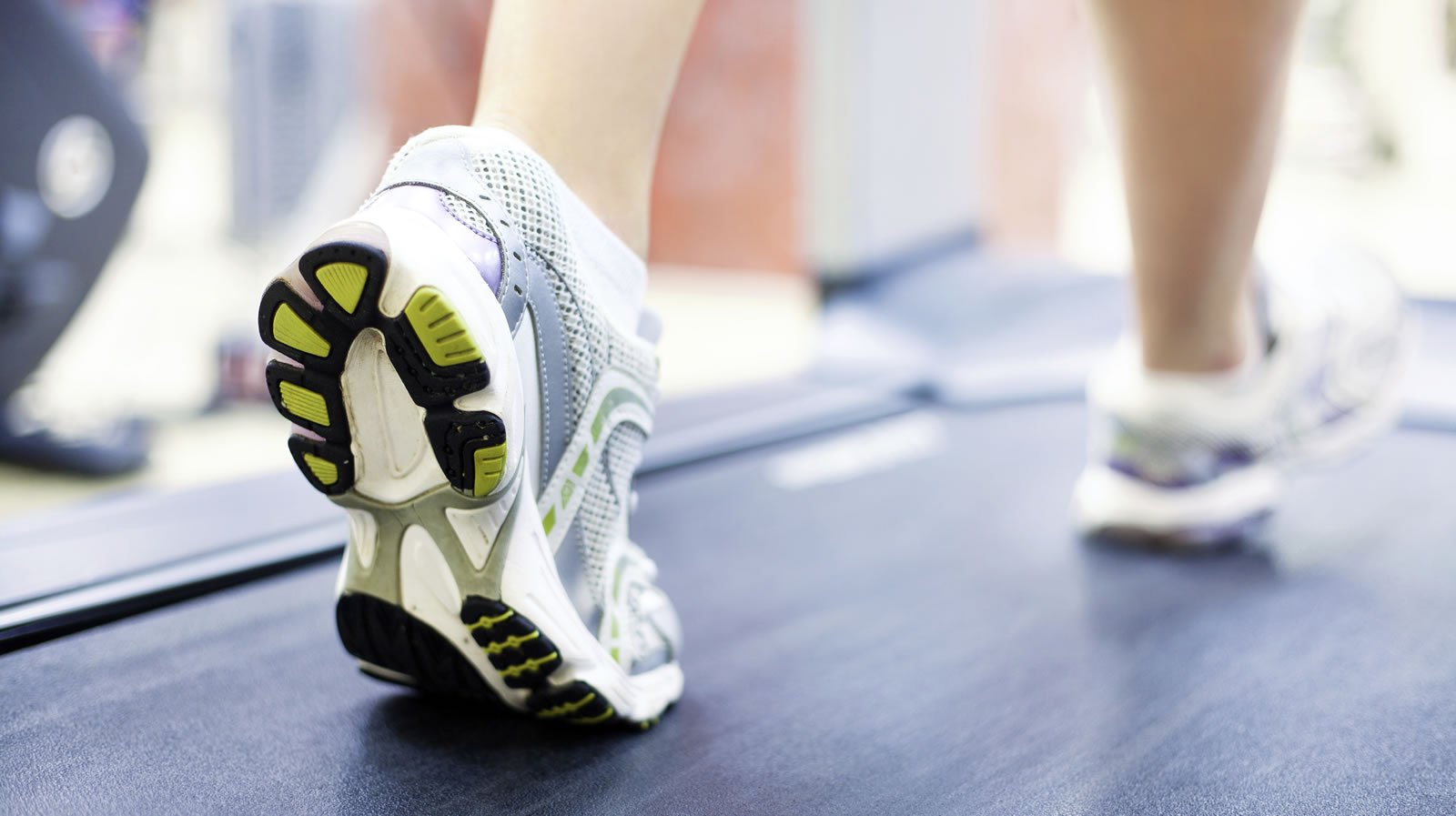“What should I do: 30 minutes of exercise or 10,000 steps a day?”
Certainly, a minimum of 30 minutes of moderate physical activity on most, if not all, days of the week is an excellent goal. But 30 minutes of exercise a day is likely not enough for someone who has a lot of weight to lose.

Want to lose weight? Live healthier? The optimal aerobic fitness plan incorporates both. Do 30 minutes of formal exercise, like a 30-minute workout on the treadmill in the gym every morning. Then count those steps toward the goal of reaching 10,000 steps for the entire day.
30 minutes of exercise
Certainly, a minimum of 30 minutes of moderate physical activity on most, if not all, days of the week is an excellent goal. Numerous studies have found that as little as a half hour daily of aerobic exercise like walking can significantly reduce the risk of heart disease, diabetes, and other cardiovascular-related illnesses.
Weight loss
“But 30 minutes of exercise a day is likely not enough for someone who has a lot of weight to lose,” points out Jamie Costello, MS, exercise physiologist and Fitness Director at the Pritikin Longevity Center in Florida, a wellness and weight-loss resort that has been teaching heart-healthy living since 1975.
The most comprehensive study1 of successful long-term weight loss ever conducted, the National Weight Control Registry, found that the vast majority of its more than 4,000 members averaged about 60 minutes of moderate exercise, like brisk walking, every day. (Brisk, as President Harry Truman so deftly defined it, is “walking as if you have somewhere to go.”)
The Registry participants in this study had lost, on average, 72 pounds, and at follow-up more than five years later had kept it off. They burned, on average, about 2,800 calories a week. If you exercise seven days a week, that’s 400 calories (about four miles) each day, or, for most people, about 60 minutes of brisk walking.
10,000 steps
So, in addition to your formal exercise, say, your 30 minutes on the treadmill or other aerobic equipment in the morning, put on a pedometer and incorporate more steps into your regular daily activities. Formal exercise steps plus steps throughout the day, adding up to a grand total of 10,000 steps, could very likely get you to the 60 minutes of daily exercise that has proven so successful for significant, long-lasting weight loss.
Three key components of exercise
And, as the exercise physiologists teach at the Pritikin Longevity Center, don’t stop with steps. Make an effort to weave all three components of optimal physical fitness into your life, not just aerobic conditioning (your steps) but also strength training (two to three times weekly) and stretching (at least two to three times weekly).
Aerobic conditioning
Aerobic workouts are great at burning calories.
Strength training
Strength training, such as lifting weights or doing calisthenics, are great at burning calories and helping you achieve a better body composition, meaning, a body with more muscle and less fat, which ultimately means a better-looking body, and very likely, a better calorie-burning body.
Stretching
Regular stretching can help ensure that your body stays flexible enough to do everything you want to do, every day, from walking to golfing to gardening to emptying the dishwasher.
Too much sitting
The other critical point is that the more you’re up and moving, the less you’re sitting. That’s important because too much sitting, science is increasingly finding, is bad news for our health and longevity even if we’re getting regular exercise, like a 30-minute aerobic workout, each day.
In one study2 that followed more than 123,000 U.S. men and women for 14 years, researchers found (not surprisingly) that those who exercised more had a lower risk of death than those who exercised less, but when the scientists looked just at the group of people who did the most exercise, those who sat for six or more hours a day suffered a significantly higher risk of premature death than those who sat for fewer than three hours daily.
Similarly, in a study3 of nearly 241,000 American adults ages 50 to 71, scientists found that among those who exercised regularly (they worked out about an hour each day), high amounts of TV viewing – seven-plus hours daily – was associated with increased risk of death compared with regular exercisers who watched TV one hour or less a day.
Why are long periods of sitting a problem? Research suggests that more sitting means fewer muscle contractions, which means the body becomes insulin resistant (less responsive to insulin), which means that fats and sugars hang around in our blood longer, leading to excess body fat and plaque build-up in our arteries.
Bottom Line: While a 30-minute aerobic workout every day is great for you, it does not make up for sitting the next eight hours in your desk chair.
How to get to 10,000 steps
To tally up your formal exercise plus your additional walking throughout the day with the goal of reaching 10,000 steps in total, here’s the math:
Your 30 minutes of formal exercise on the treadmill add up to about two miles, or around 4,000 steps. (Though the number of steps can vary depending on your stride and speed, one mile tends to be about 2,000 steps).
So, you’ve got 6,000 more steps to go, or about another two to three miles.

Learn More About Pritikin
You can do it!
Throughout the day, pedometer strapped to your belt or worn as a bracelet in the form of digitalized brands such as Jawbone and Fitbit, take advantage of all those seemingly small movement opportunities.
Park at the far end of the parking lot. Take the stairs instead of the elevator. Walk while you talk on the phone. While flying, Nathan Pritikin used to stride up and down the aisles of the airplane. (Yes, he got a few dirty looks from the flight attendants, but he just smiled graciously and kept moving.)
You can even step in place while waiting in line at the grocery store. If you get funny looks, just point to your pedometer and say “doctor’s prescription.”
No sweat
And here’s the really good news. You don’t have to break into a sweat. Simply getting out of your chair every half hour or so and strolling around for a couple of minutes can reap big benefits. Science4 has found that blood sugar and insulin sensitivity improve, cholesterol and triglycerides improve, and levels of lipoprotein lipase, an enzyme that aids in the breakdown of fat in the bloodstream, improve – all of which can significantly impact overall health.
Counting Steps for Fitness
What’s more, you’ll likely be surprised at how quickly and easily you reach 10,000 steps, for a grand total of 4 to 5 miles every day. Now that’s how you lose weight – lots of weight – and keep it off, as the National Weight Control Registry members learned. And that’s how you help keep your blood sugar and other metabolic factors in good working order all day long.
3,500 calories equals 1 pound of fat
“Here’s another way to look at it,” offers Pritikin’s Fitness Director Jamie Costello. “If all you do is walk briskly for 30 minutes, you’ve burned just 200 calories. Since 3,500 calories is a pound of fat, you’d need 17.5 days to lose one single pound. At most, you’d be losing two pounds a month. Sure, you’re headed in the right direction, but if you have 50 to 100 pounds to lose, it would take two to four years to shed the weight.”
What is 10000 Steps Equal To?
“But,” continues Jamie, “if you walk briskly for 30 minutes and include enough activity throughout the day to reach the combined total of 10,000 steps, you’re burning about 400 to 500 calories a day, which means you’re losing one pound each week.”
Pritikin Eating Plan
And that’s just from exercise! By following the Pritikin Eating Plan, you’re probably reducing your calorie intake at least 500 calories a day, which means you’re shedding a combined total of about two pounds every week. If you have 50 to 100 pounds to lose, you can do it in six months to a year. Big difference!
By all means, do more if you can. An hour in the gym (400 to 500 calories) plus 6,000 steps of being active throughout the day (300 calories) plus following the Pritikin Eating Plan (500-calorie deficit) nets you about a three-pound weight loss every week. That’s potentially a loss of 50 pounds in just four months.
Summing up | 30 minutes of exercise or 10,000 steps a day?
“Take advantage of both fitness tools – formal exercise and stepping throughout the day,” encourages exercise physiologist Jamie Costello. “I always say to our guests at Pritikin: ‘You have 24 hours in each day. If you sleep eight, that leaves 16. Which do you think is more important: the activity you get in the 30 to 60 minutes in the gym or the amount of activity you get in the remaining 15 hours of the day?’
“The answer is both: formal exercise plus an active lifestyle.”
But ultimately, what’s most critical for health and long-term weight loss is not just exercise. It’s launching a new way of life that focuses on fitness as well as healthy eating and a healthy attitude, all of which we teach at the Pritikin Longevity Center.
Yes, tools like Fitbits can help. But remember, they’re just tools. We need to be inspired to use these tools, and that’s what a healthy retreat like Pritikin gives you.
“You become a new person here,” smiles Costello. “You’re getting leaner, stronger. Every morning you’re waking up with a burst of energy, and the promise of progress. You’re challenging yourself in ways you never imagined was possible.
“You have new motivation. You’re excited about utilizing the many tools you’ve learned here so that you can keep feeling this good.”

Get All the Details of a Stay at the Pritikin Center in Your Inbox
Sources
1American Journal of Clinical Nutrition, 2005; 82 (1): 2225.
2American Journal of Epidemiology, 2010; 172 (4): 419.
3American Journal of Clinical Nutrition, 2012; 95 (2): 437.
4Diabetes Care, 2012; 35 (5): 976.